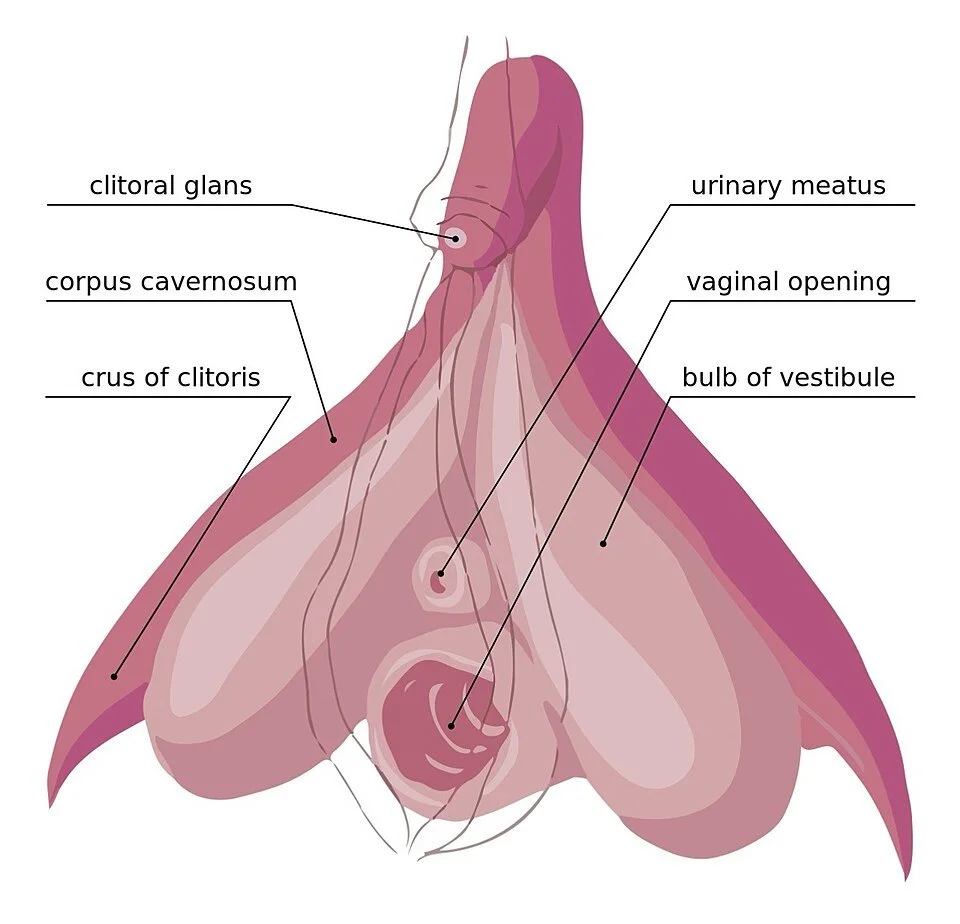The Anatomy of the Clitoris: Why Pleasure Starts Here, Not the “G-Spot”
Written by Elizabeth Bird, PhDYes, I’m writing a post on this. It deserves its own entire post. Why? Because the clitoris is not only central to sexual pleasure, but even many medical doctors aren’t fully taught about the clitoral structure.
I tried looking for a diagram of the clitoris in the stock images provided on Squarespace for this post and you know what I found? Bananas, mushrooms, various long vegetables, some grapefruits, some abstract art of crying people (yes, really), and you know what else? Penis diagrams. You know what I did not find? A diagram of a clitoris.
Dr. Rachel Rubin, a urologist and sexual medicine expert who I’ve had the pleasure of learning from and meeting with, is a fierce advocate for better research and education in this area. You can watch her talk on PBS News Hour.
What Is the Clitoris?
The clitoris is often described as the only organ in the human body whose sole purpose is sexual pleasure. But it’s not just the glans (or “head”) that you see on the outside.
The clitoris extends internally into the pelvis, with two main parts:
Crura (legs) that reach down along the pubic bone
Bulbs (vestibular bulbs) that wrap around the vaginal canal and urethra
This means vaginal penetration doesn’t stimulate the vaginal walls directly (which are relatively numb). Instead, penetration stimulates the clitoral complex from the inside.
Everything in this image below is part of the clitoris except for the urethral and vaginal openings.
What the clitoris actually looks like
Clitoral Anatomy and Sexual Arousal
The clitoris is made of erectile tissue—just like the penis. During arousal, blood flows into these tissues, causing them to swell, change color, and become more sensitive.
This engorgement happens both externally (the glans) and internally (the bulbs and crura). That warm, full feeling inside the vulva? A big part of those sensations are the clitoral structures becoming erect.
Because of this, penetration feels pleasurable mainly when the person is already aroused. Much of the pleasure of penetration comes from something (fingers, toy, penis, etc) stimulating the internal clitoral structures through the vaginal canal. Also, without arousal, the vaginal canal hasn’t elongated or “tented” to make space, which can make penetration feel tight, uncomfortable, or even painful.
Key takeaway: For most it’s arousal first, then penetration—not the other way around.
The Truth About the G-Spot
One of the most common questions I hear is: What about the G-spot?
Here’s the truth: the idea that there is a magical “spot” is a myth. Cosmo even wrote an article where they apologized for providing misinformation and talk about the history of the debate.
So why the hype around the G-spot? Much of it comes from cultural emphasis on penile-vaginal intercourse as the “main event.” But research shows:
In Dr. Laurie Mintz’s surveys, 15–30% of women say they can orgasm from penetration alone—but only *4% say it’s their most reliable method.
70% of women pair vaginal penetration with manual stimulation of the glans (external clitoris) to make penetration more pleasurable.
76% of women use a “rocking” technique during vaginal penetration to rub the glans of the clitoris on the base of a toy or penis while keeping the insertion deep (rather than pulling in and out).
The clitoris, not the mythical G-spot, is the real source of sexual pleasure.
Some people feel like they do have a specific area in the vagina that feels good when stimulated. If you have found something that feels good to you, incorporate it! If you don’t like something that someone else likes, ditch it (or you can try it in a different context or when you are already aroused but if it still isn’t your jam, you are not broken and you do not need to continue to try to like it).
Why Clitoral Anatomy Matters
Understanding clitoral anatomy is important for more than just pleasure. It helps with:
Better sexual health care – doctors can better assess pain, arousal issues, or post-surgical complications.
Reducing stigma – normalizing conversations about sexual response.
Empowerment – knowing your body helps you advocate for what feels good.
Learning More
A wonderful resource exists to help you learn more about female pleasure. Check out OMGYes (even Emma Watson has sung its praises!)
*Please note that once you pay to view the website, the site includes videos of real women engaged in real solo pleasure. It is not meant for the sexual gaze or thought of as pornography but it is explicit. The website discusses evidence based techniques and information on women’s sexual pleasure.
The Bottom Line
The clitoris is not just a “button”—it’s a complex internal and external organ designed for pleasure.
When we understand how the clitoris really works, we can:
Improve sexual satisfaction
Reduce frustration and shame
Advocate for better medical and sexual education
Knowledge is power. And in this case, knowledge is also pleasure.
If it is difficult for you to get aroused during sexual activity or if you aren’t sure how to increase pleasure for yourself or your partner, a sex therapist can meet with you alone or together to figure out your sexual roadmap.

